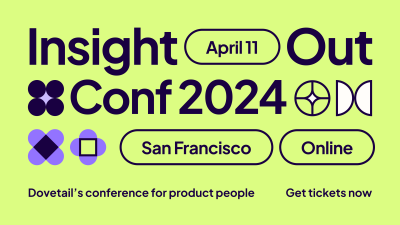A brief history of UX design with Donna Spencer
Donna Spencer wears many hats. She’s a designer, facilitator, a regular speaker on the conference circuit, and an all-around guru when it comes to the user experience craft. Spencer has also worked in the industry for two decades now, where she’s had a front-row seat to the explosion of the UX discipline.
From relative obscurity to a key business differentiator, the way the business world looks at user experience has transformed product thinking forever. As people who live and breathe it every day, we thought it would be instructive (and fun!) to take a trip down memory lane. To explore the shifts in thinking around the discipline over the years, plotting its course from the darkness of development-driven products into the light of the user-centric present.
So without further ado, let’s learn a thing or two about the evolution of UX from the perspective of a woman who’s spent her professional life at its coalface.
Tell us about your early experiences in UX.
In the late nineties, when I started working in what is now called user experience, everybody was talking about usability. There wasn’t consistent terminology back then, and I was mostly acting as a consultant because there weren’t many in-house jobs. It was the early days of the web. Software was difficult to use. So a lot of the field and academic contributions were around a Jacob Neilson-style of usability. Jared [Spool] has this great quote, “We don’t talk about edibility in food. We should be doing better than that.” But that’s where we were.
Who were the primary drivers of usability and UX back then?
There weren’t a lot of people focusing on it. Software design and development was mostly done from a development-focused approach, not a user-focused approach. Sometimes that can result in good products. Often, it doesn’t result in good products because you haven’t thought about the flow of people and the fact folks don’t know about the product the way you do. Developers or makers know it in detail, the nitty-gritty, the data, and the jargon. It’s hard to make great products if you can’t break that down for the people using it who may not have your existing knowledge.
At that time, the idea of usability started to gain more prominence. In the early 2000s, the web was growing along with the number of companies putting content on websites. This led to the emergence of information architecture, which tried to solve a lot of fundamental problems. Like, how do you do basic navigation? How do you group and categorize content so people can use it? How do we start introducing user-centered approaches into our work? There was a stronger focus on UX around that time that began to leak in with ideas like contextual design and research.
What was the motivation for pursuing more user-focused design during this time?
It was a mix. A lot of it was individuals realizing our products weren’t very good and people, maybe having read some books or done some academic reading, saying, “actually, there’s a better way to do this by focusing on the users.” But it wasn’t across the board. In the early 2000s, we were all pushing and fighting to get research done. I look at it now, and it’s still not universal, but researchers are part of the process, where 15 to 20 years ago, it was difficult to do any research.
It took several years for the business side of the equation to realize that there was money to be made or saved by focusing more on users. And again, that’s not universal—but it’s certainly more obvious now.
When did you first notice the emergence of specialist researchers in product teams?
I saw that start to happen after gov.uk got started. Gov UK was high profile, and its user-centered, research-focused approach contributed significantly to its success. It was there where I saw design specializations starting to fall out, as well. Rather than just user experience designers, Gov UK and the Australian government also had roles like user researcher, content designer, and service designer, which nobody ever used much elsewhere.
Do you think research will get a seat at the table, similar to design?
I think product managers and product owners are firmly at the table. I’m not sure if designers are.
Do you think designers are still searching for that seat at the table?
Design can be used in two quite different ways. The word design in our field can mean strategic decision-making, but it also can mean making screens. Those designers making high-fidelity screens, working in product teams are not getting any seat at the decision-making table—they’re being told to make the thing. And I think they’re probably not super happy about what they were told design was.
Some companies understand that solving problems in new ways by understanding customers is a good thing. In that regard, the broad concept of design has a place. But those two things don’t necessarily bridge.
Do you think research will have a more strategic role in the future?
Often when people are struggling to get buy-in, they haven’t understood their role and context. They haven’t researched the organization to understand how to communicate their value. So when researchers are saying, “We need to do research. It’s super-important you should just believe me,” I know they haven’t looked at what matters to the company. Is this company going through a transformation? Is it trying to save money? What drives it? How do people make decisions? If you understand that, then you can understand what research is and understand what it does. And then you can be the bridge between the company goals and their customers.
What predictions for the future do you have about the UX discipline?
I don’t like predicting the future, so I’m going to extrapolate from the present. That’s all my head can do.
I have seen roles become more granular, and I’m seeing UX become less focused on the “U” and more about the making of screens. If you are working in a product team as a UX/UI person and making high-fidelity screens, there is no user in that. So it’s not UI/UX. It’s interface design because there’s little to no incorporation of the user in that process. Over the past few years, more and more designers have come out of programs like boot camps, and more and more companies are hiring designers. We didn’t have very many people with a focus on design on teams in the past. Now there seem to be zillions. I’m not entirely sure what they do.
Compared to how we did it in the past, designers could be more generalist, and entire teams would weigh in to solve customer problems. I don’t know what will happen in the future, but I think it’ll keep fragmenting. I don’t know that hiring a lot of designers and sticking them on small agile teams to do feature-based screens will make any of our products much better, though.
Get started for free
Log in or sign up
Get started for free
or
By clicking “Continue with Google / Email” you agree to our User Terms of Service and Privacy Policy


